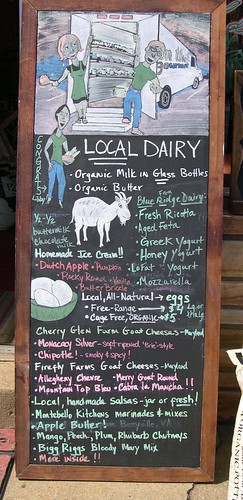This post is part of the Science Tuesday feature series on the USDA blog. Check back each week as we showcase stories and news from the USDA's rich science and research portfolio.
By Michael Hand, Economist, Economic Research Service
Anyone who has shopped at a farmers market on a weekend morning can appreciate the freshness of the food, the interaction with farmers, and the ability to know where and by whom the food was produced. Demand for locally produced food has increased sharply in recent years, precisely because of such consumer preferences.
As an economist, I’m interested in how locally grown food is supplied – specifically, how local food supply chains compare with mainstream chains in delivering products from farm to consumer. With a group of my colleagues in the profession, I conducted a series of 15 case studies to help understand these dynamics.
The case studies covered locally produced apples, blueberries, spring mix greens, beef, and fluid milk, each in a different major metropolitan area. In each of the five product-place groupings, we looked at three types of supply chains: direct market (e.g., farmers markets or home delivery); intermediated (sales through natural foods chains or institutions); and mainstream (e.g., supermarkets).
We visited and talked with farmers, cooperative grocery stores, retail distribution centers, food processors, and supermarkets. Larry Thompson, for example, farms 145 acres within 20 miles of downtown Portland, OR, and focuses his sales of blueberries through farmers markets and farm stands. Edwin Shank operates a 250-cow grass-based organic dairy in Southeastern Pennsylvania; he supplies milk to a processor ten miles away that delivers milk and other dairy products to MOM’s Organic Market stores in the Washington, DC area.
Their stories, their business models and decisions, and those of other players we interviewed, indicate the wide variety of ways local foods reach consumers. Our case studies provide details that, along with publicly available data, will likely be of interest to farmers, entrepreneurs, and retail operators, as well as researchers and policymakers.
Among our findings is that producers receive a greater share of retail prices in local supply chains than they do in mainstream chains, and their net revenue is higher despite the cost of undertaking the distribution and marketing themselves. Interestingly, while “food miles” are lower in the local supply chains, fuel use per unit of product varies across locations and products. This finding is an example of the need for further research on the relative environmental impacts across supply chains.

Cheri Fletcher (l.) and Lauren Michael, of Thompson Farms in Boring, Oregon, set up a stall at a local farmers market.
Credit: Courtesy Thompson Farms and Boring Farmers Market

A sign inside the Maple Avenue Market in Vienna, Virginia promotes locally produced dairy products and other foods.
Courtesy Gary Jeter.

